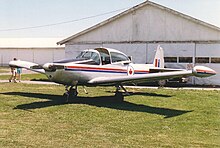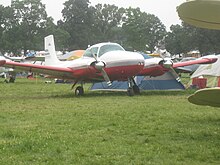
The Piper PA-32 Cherokee Six is a series of single-engine, fixed landing gear, light aircraft manufactured in the United States by Piper Aircraft between 1965 and 2007.
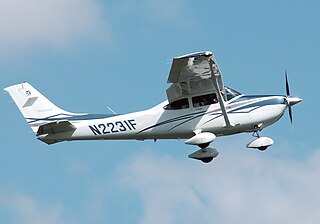
The Cessna 182 Skylane is an American four-seat, single-engined light airplane built by Cessna of Wichita, Kansas. It has the option of adding two child seats in the baggage area.

The Globe GC-1 Swift, also known as the Globe/Temco Swift, is a light, two-seat sport monoplane from the post-World War II period.
The Aero Boero AB-210 is an Argentine civil utility aircraft, a development of the AB-180 with improved performance delivered by a fuel-injected engine. Unlike previous aircraft by this manufacturer, it also featured tricycle undercarriage, but retained the same general high-wing configuration. Only a single prototype was built, first flying on 22 April 1971.
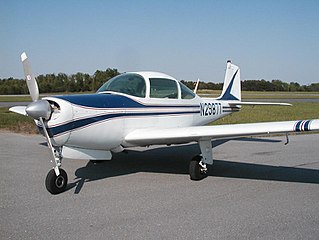
The Meyers 200 is a single-engined light aircraft produced in the United States in the 1950s and 1960s.

The Cessna 205, 206 and 207, known primarily as the Stationair, are a family of single-engined, general aviation aircraft with fixed landing gear, used in commercial air service as well as for personal use. The family was originally developed from the popular retractable-gear Cessna 210 and produced by the Cessna Aircraft Company.
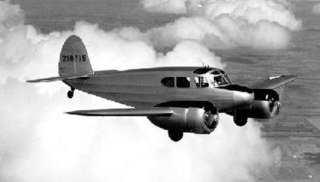
The Cessna AT-17 Bobcat or Cessna Crane is a twin-engine advanced trainer aircraft designed and made in the United States, and used during World War II to bridge the gap between single-engine trainers and larger multi-engine combat aircraft. The commercial version was the Model T-50, from which the military versions were developed.
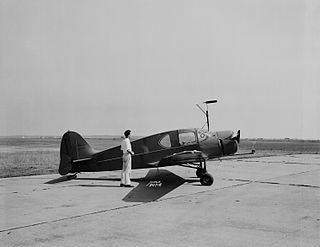
The Bellanca 14-7 Cruisair and its successors were a family of single-engined light aircraft manufactured in the United States from the mid-1930s onwards.

The Cessna 185 Skywagon is a six-seat, single-engined, general aviation light aircraft manufactured by Cessna. It first flew as a prototype in July 1960, with the first production model completed in March 1961. The Cessna 185 is a high-winged aircraft with non-retractable conventional landing gear and a tailwheel.

The Cessna 310 is an American four-to-six-seat, low-wing, twin-engine monoplane produced by Cessna between 1954 and 1980. It was the first twin-engine aircraft that Cessna put into production following its first twin, the Cessna T-50 manufactured for World War II.

The Luscombe 8 is a series of high-wing, side-by-side-seating monoplanes with conventional landing gear, designed in 1937 and built by Luscombe Aircraft.

The Dornier Do 27 is a German single-engine STOL utility aircraft that was designed and manufactured by Dornier GmbH. It was notable for being the first mass-produced aircraft in Germany following the end of the Second World War.

The Bellanca Viking and Super Viking are a series of single-engine, four-seat, high performance, retractable gear aircraft manufactured in the USA during the 1960s and 1970s. The aircraft developed through modifications of classic designs by the aviation pioneer Giuseppe Bellanca. A total of 1,356 Vikings have been produced with most production between 1968 and 1975.

The Auster J/5 Autocar was a late 1940s British single-engined four-seat high-wing touring monoplane built by Auster Aircraft Limited at Rearsby, Leicestershire.

The Piper PA-36 Pawnee Brave is a 1970s American single-engined, low-wing, propeller-driven agricultural plane built by Piper Aircraft.
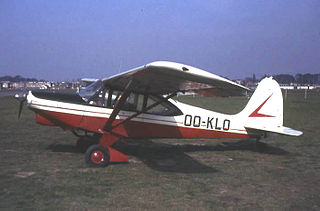
The Boisavia B.60 Mercurey was a series of four-seat light aircraft developed in France shortly after World War II.

The Call-Air Model A is an American two- to three-seat utility aircraft designed by the Call brothers and built by the Call Aircraft Company, later developed into a successful line of agricultural aircraft.

The Camair Twin Navion was a civil utility aircraft produced in the United States in the 1950s by converting single-engine Ryan Navions to twin-engine power. It had been one of two programs to improve the performance of the otherwise-pleasing Navion that was generally considered to be underpowered. The other program had resulted in the TEMCO-Riley D-16A Twin Navion. The Twin Navion design had been undertaken by the White brothers of White Engineering in San Antonio, Texas. They replaced the Navion's engine with a baggage compartment, mounted two engines within new nacelles attached to the wing leading edges, fitted the aircraft with a new tail fin made of fiberglass, and added tip tanks made from recycled WWII napalm canisters. Designated the WE-1, the prototype and the rights were sold to Camair soon after its first flight in 1953 and Civil Aviation Authority type certification was achieved in May 1955 under the name Camair 480. Sales were slow and Camair built only 25 examples before selling off the rights in 1959. The ownership of these rights would change hands twice again over the following decade but only another eight aircraft would be built after the end of Camair's involvement
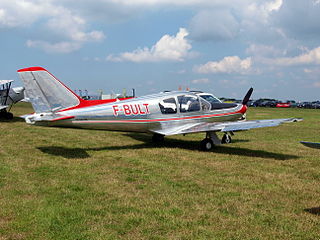
The Procaer F.15 Picchio is an Italian-designed light utility aircraft built by Procaer.

The Temco D-16 is a 1950s twin engine civil aircraft from the United States. It was produced by conversion of a Ryan Navion to replace its single engine with two wing-mounted engines. It is commonly known as the Twin Navion, although that name is also often applied to a later similar conversion, the Camair 480.



